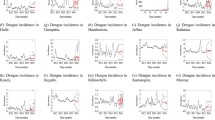Abstract
Dengue Fever (DF) has been identified by the World Health organization (WHO) as one of the most serious vector-borne infectious diseases in tropical and sub-tropical areas. During 2007, in particular, there were over 2,000 DF cases in Taiwan, which was the highest number of cases in the recorded history of Taiwan epidemics. Most DF studies have focused mainly on temporal DF patterns and its close association with climatic covariates, whereas they have understated spatial DF patterns (spatial dependence and clustering) and composite space–time effects. The present study proposes a spatio-temporal DF prediction approach based on stochastic Bayesian Maximum Entropy (BME) analysis. Core and site-specific knowledge bases are considered, including climate and health datasets under conditions of uncertainty, space–time dependence functions, and a Poisson regression model of climatic variables contributing to DF occurrences in southern Taiwan during 2007. The results show that the DF outbreaks in the study area are highly influenced by climatic conditions. Furthermore, the analysis can provide the required “one-week-ahead” outbreak warnings based on spatio-temporal predictions of DF distributions. Therefore, the proposed approach can provide the Taiwan Disease Control Agency with a valuable tool to timely identify, control, and even efficiently prevent DF spreading across space–time.







Similar content being viewed by others
References
Aldstadt J (2007) An incremental Knox test for the determination of the serial interval between successive cases of an infectious disease. Stoch Environ Res Risk Assess 21(5):487–500
Arcari P, Tapper N, Pfueller S (2007) Regional variability in relationships between climate and dengue/DHF in Indonesia. Singap J Trop Geogr 28(3):251–272
Christakos G (1992) Random field models in earth sciences. Academic Press, Inc, San Diego
Christakos G (2000) Modern spatiotemporal geostatistics. OUP, Oxford
Christakos G, Hristopulos DT (1998) Spatiotemporal environmental health modelling: a tractatus stochasticus. Kluwer Academic, Boston
Christakos G, Bogaert P, Serre ML (2002) Temporal GIS: advanced functions for field-based applications. Springer-Verlag, New York, NY
Christophers SR (1960) Aedes aegypti (L.), the yellow fever mosquito: its life history, bionomics, and structure. Cambridge University Press, Cambridge
Diggle PJ, Tawn JA, Moyeed RA (1998) Model-based geostatistics. J R Stat Soc, Appl Stat 47:299–326
Halide H, Ridd P (2008) A predictive model for dengue hemorrhagic fever epidemics. Int J Environ Health Res 18(4):253–265
Hurtado-Diaz M, Riojas-Rodriguez H, Rothenberg SJ, Gomez-Dantes H, Cifuentes E (2007) Short communication: impact of climate variability on the incidence of dengue in Mexico. Trop Med Int Health 12(11):1327–1337
Ko K-C (1998) On the monthly means and anomalies of the sea surface temperature and 850 hPa wind fields during the 1997–98 El Nino. Environ Worlds (2):67–84 (in Chinese)
Kuhn K, Campbell-Lendrum D, Haines A, Cox J (2005) Using climate to predict infectious disease epidemics. World Health Organization, Geneva, Switzerland
Lifson AR (1996) Mosquitoes, models, and dengue. Lancet 347(9010):1201–1202
Luz PM, Mendes BVM, Codeco CT, Struchiner CJ, Galvani AP (2008) Time series analysis of dengue incidence in Rio de Janeiro, Brazil. Am J Trop Med Hyg 79(6):933–939
Maidana NA, Yang HM (2008) Describing the geographic spread of dengue disease by traveling waves. Math Biosci 215(1):64–77
Mikler AR, Venkatachalam S, Ramisetty-Mikler S (2007) Decisions under uncertainty: a computational framework for quantification of policies addressing infectious disease epidemics. Stoch Environ Res Risk Assess 21(5):533–543
Mondini A, Neto FC, Sanches MGY, Lopes JCC (2005) Spatial analysis of dengue transmission in a medium-sized city in Brazil. Rev Saude Publ 39(3):444–451
Nishiura H (2006) Mathematical and statistical analyses of the spread of dengue. Dengue Bull 30:51–67
Otero M, Solari HG, Schweigmann N (2006) A stochastic population dynamics model for Aedes aegypti: formulation and application to a city with temperate climate. Bull Math Biol 68(8):1945–1974
Otero M, Schweigmann N, Solari HG (2008) A stochastic spatial dynamical model for Aedes aegypti. Bull Math Biol 70(5):1297–1325
Patz JA, Martens WJM, Focks DA, Jetten TH (1998) Dengue fever epidemic potential as projected by general circulation models of global climate change. Environ Health Perspect 106(3):147–153
Pebesma EJ, Duin RNM, Burrough PA (2005) Mapping sea bird densities over the North Sea: spatially aggregated estimates and temporal changes. Environmetrics 16(6):573–587
Reiter P (2001) Climate change and mosquito-borne disease. Environ Health Perspect 109:141–161
Smith DL, Dushoff J, McKenzie FE (2004) The risk of a mosquito-borne infection in a heterogeneous environment. Plos Biol 2(11):1957–1964
Tamerius JD, Wise EK, Uejio CK, McCoy AL, Comrie AC (2007) Climate and human health: synthesizing environmental complexity and uncertainty. Stoch Environ Res Risk Assess 21(5):601–613
Tran A, Raffy M (2006) On the dynamics of dengue epidemics from large-scale information. Theor Popul Biol 69(1):3–12
Wen TH, Lin NH, Lin CH, King CC, Su MD (2006) Spatial mapping of temporal risk characteristics to improve environmental health risk identification: a case study of a dengue epidemic in Taiwan. Sci Total Environ 367(2–3):631–640
WHO (1997) Dengue haemorrhagic fever: diagnosis, treatment, prevention and control. World Health Organization, Geneva
WHO (2009) Dengue and dengue haemorrhagic fever. Available at http://www.who.int/mediacentre/factsheets/fs117/en/. Accessed 2009
Wu PC, Guo HR, Lung SC, Lin CY, Su HJ (2007) Weather as an effective predictor for occurrence of dengue fever in Taiwan. Acta Trop 103(1):50–57
Yang H, Macoris M, Galvani K, Andrighetti M, Wanderley D (2009) Assessing the effects of temperature on the population of Aedes aegypti, the vector of dengue. Epidemiol Infect 137:1–15
Yu H-L, Kolovos A, Christakos G, Chen J-C, Warmerdam S, Dev B (2007) Interactive spatiotemporal modelling of health systems: the SEKS–GUI framework. Stoch Environ Res Risk Assess 21(5):555–572
Acknowledgments
This research was supported by grants from the National Science Council of Taiwan (Grant No. NSC97-2313-B-002-002-MY2 and NSC98-2625-M-002-012) and the California Air Resources Board, USA (55245A).
Author information
Authors and Affiliations
Corresponding author
Rights and permissions
About this article
Cite this article
Yu, HL., Yang, SJ., Yen, HJ. et al. A spatio-temporal climate-based model of early dengue fever warning in southern Taiwan. Stoch Environ Res Risk Assess 25, 485–494 (2011). https://doi.org/10.1007/s00477-010-0417-9
Published:
Issue Date:
DOI: https://doi.org/10.1007/s00477-010-0417-9




